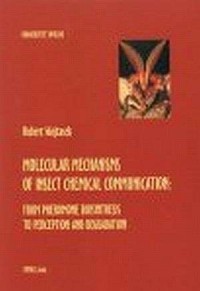Molecular mechanisms of insect chemical communication: From pheromone biosynhesis to perception and degradation
Hubert Wojtasek

| Dane szczegółowe: | |
| Wydawca: | Wydawnictwo Uniwersytetu Opolskiego |
| Oprawa: | miękka |
| Ilość stron: | 108 s. |
| Wymiar: | 167x240 mm |
| EAN: | 9788388796616 |
| ISBN: | 83-88796-61-5 |
| Data: | 2007-06-26 |
Opis książki:
Chemical signals govern a large part of insect behavior and physiology. Within a species chemical communication is mediated by pheromones. Insect pheromones are described briefly, with particular emphasis on sex attractants. Identification of pheromones is presented using the example of an unusual, caffeine-like alkaloid, 1,3-dimethyl-2,4-(1H,3H)-quinazo-linedione, the sex pheromone of the pale-brown chafer, Phyllophertha diversa. Biosynthetic pathways are described for pheromones from the best studied insect orders (Lepidoptera, Coleoptera, Diptera and Dictyoptera). The methodology for establishing the biosynthetic routes is presented using unsaturated g -lactones, the sex pheromones of a number of scarab beetles. Evidence is shown that these semiochemicals are biosynthesized from fatty acids by desaturation, hydroxylation, chain shortening and cyclization reactions. The hydroxylation reaction is remarkably stereospecific in two species: the Osaka beetle (Anomala osakana) and the Japanese beetle (Popillia japonica). Molecular mechanisms of pheromone perception are presented, with the emphasis on the perireceptor events, taking place in the sensillar lymph. Pheromone binding proteins (PBPs), transporting the pheromones from the environment to the receptor neurons, are described in detail. Purification, cloning, and ligand binding specificity of two new classes of these proteins identified in scarab beetles are described. Preparation of the recombinant PBP from the silkworm moth, Bombyx mori, expressed in Escherichia coli periplasm, is presented. Structural changes induced by p H change in this protein and the odorant binding protein from P. diversa, and a similar conformational transition in B. mori PBP in the pre-sence of model phospholipid membranes, are described. A novel mechanism of ligand transport through the sensillar lymph and its release upon encountering the surface of olfactory neurons is proposed based on these structural studies. Enzymatic inactivation of pheromones by sensillar enzymes is described. Degradation of g -lactones in several species of scarab beetles is analyzed and antennal esterases metabolizing these compounds are characterized. Substantial substrate specificity for the natural stereoisomer is demonstrated in two cases (Anomala octiescostata and P. japonica). Degradation pathway of 1,3-dimethyl-2,4-(1H,3H)-quinazolinedione is also analyzed. Evidence is presented that this molecule is metabolized by a specific, olfactory cytochrome P450 by N-de-methylation and hydroxylation of the aromatic ring. Potential applications for results of molecular studies of insect chemical communication are discussed.
Książka "Molecular mechanisms of insect chemical communication: From pheromone biosynhesis to perception and degradation" - Hubert Wojtasek - oprawa miękka - Wydawnictwo Uniwersytetu Opolskiego.

